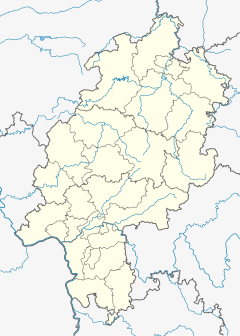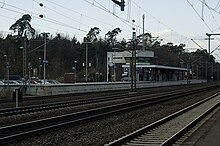The railways in Germany use several abbreviations to differentiate between various types of stations, stops, railway facilities and other places of rail service.

Mannheim Hauptbahnhof is a railway station in Mannheim in the German state of Baden-Württemberg. It is the second largest traffic hub in southwestern Germany behind Stuttgart Hauptbahnhof, with 658 trains a day, including 238 long-distance trains. It is also a key station in the Rhine-Neckar S-Bahn. 100,000 passengers embark, disembark or transfer between trains at the station each day. The station was modernised in 2001. It is classified by Deutsche Bahn as a category 2 station.
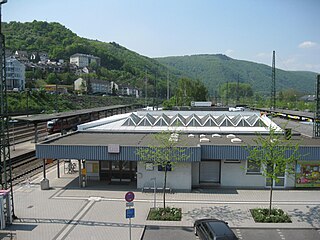
Bingen (Rhein) Hauptbahnhof is a railway station in the German city of Bingen am Rhein on the West Rhine Railway. It is located in the borough of Bingerbrück. The station that serves central Bingen is called Bingen Stadt.
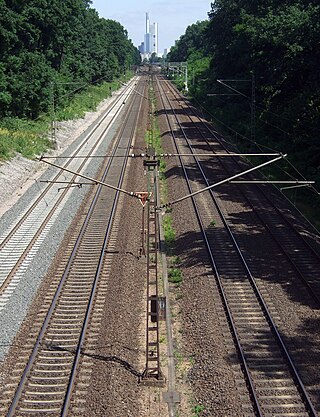
The Main-Neckar Railway is a main line railway west of the Odenwald in the Upper Rhine Plain of Germany that connects Frankfurt am Main to Heidelberg via Darmstadt, Bensheim and Weinheim. It was opened in 1846 and is one of the oldest railways in Germany.
The Rhine-Main Railway, is a railway line in southern Germany from Mainz via Darmstadt to Aschaffenburg. It was built by the Hessian Ludwig Railway and opened on 1 August 1858 and is one of the oldest railways in Germany. Until 1862, when the railway bridge over the Rhine river constructed and assembled by MAN-Werk Gustavsburg was finished, a train ferry operated on the river.

Heidelberg Hauptbahnhof is the main railway station for the city of Heidelberg. In 2005 it was used by around 42,000 passengers per day and is one of the largest passenger stations in the German state of Baden-Württemberg. The station is classified by Deutsche Bahn as a category 2 station.

Kempten (Allgäu) Hauptbahnhof is a railway station in Kempten in the German state of Bavaria. It is the most important station of Kempten and a hub for the Neu-Ulm–Kempten railway, the Buchloe–Lindau railway and the Ausserfern Railway. The original Kempten station was built in 1852 as a terminal station near the centre of town and was replaced by a through station in 1969.

Weinheim (Bergstraße) Hauptbahnhof is a station in the town of Weinheim in the German state of Baden-Württemberg. It is served by Intercity services on the Main-Neckar Railway between Frankfurt and Heidelberg/Mannheim. The Weschnitz Valley Railway (Weschnitztalbahn) to Furth in the Odenwald starts at Weinheim station. There is also a freight railway to Viernheim, the last remaining section of the former Weinheim–Worms railway.

Dreieich-Buchschlag station is a railway station on the Rhine-Main S-Bahn in the town of Dreieich in the German state of Hesse. It was opened in 1879 on the Main-Neckar Railway. The station is classified by Deutsche Bahn as a category 4 station.
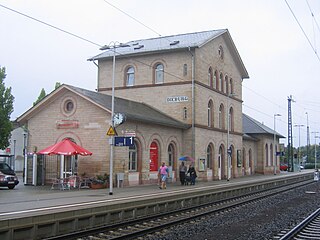
Dieburg station is located in the town of Dieburg in the German state of Hesse on the Rhine-Main Railway, which runs from Mainz via Darmstadt to Aschaffenburg. The Rodgau Railway from Offenbach am Main now ends here. The station is classified by Deutsche Bahn as a category 4 station. It is served only by local trains.

Frankfurt-Griesheim station is a railway station located in the Griesheim district of Frankfurt, Germany.

Friedrichsdorf (Taunus) station is in the centre of Friedrichsdorf on Bahnstraße. Although the city has mostly dispensed with the appendage of "Taunus" in its name the station still officially retains it, although signs on the newest platform and Rhein-Main-Verkehrsverbund maps do not include it. The station is classified by Deutsche Bahn as a category 4 station.

Stadtallendorf station is a through station at the 82.1 km mark of the Main-Weser Railway in the town of Stadtallendorf in the German state of Hesse. The station is classified by Deutsche Bahn (DB) as a category 4 station. The platforms, underpass and the area around the station were modernised and redecorated in preparation for the Hessentag celebrations of 2010.
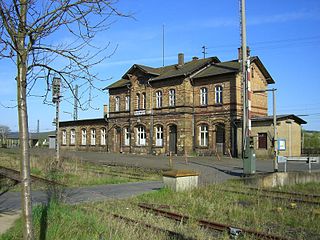
Niederwalgern station is a station on the Main-Weser Railway in the town of Niederwalgern in the German state of Hesse, south of Marburg. It is the only station of the town and the largest in the municipality of Weimar (Lahn). The station is classified by Deutsche Bahn (DB) as a category 5 station. The station is heritage-listed under the Hessian Heritage Act.

Memmingen station in the city of Memmingen in the German state of Bavaria. The current station building had two predecessors, with the original being opened in 1862. The Buchloe–Memmingen and the Leutkirch–Memmingen railways meet the Neu-Ulm–Kempten railway in Memmingen. The route from Munich to Zurich through Memmingen station is planned to be upgraded for tilting trains and electrified.

Neu-Edingen/Mannheim-Friedrichsfeld station is a separation station in the Mannheim district of Friedrichsfeld on the border with the municipality of Edingen-Neckarhausen in the German state of Baden-Württemberg. All rail tracks are in Mannheim, only the station building is located on the territory of the Edingen-Neckarhausen hamlet of Neu-Enghien. It is classified by Deutsche Bahn as a category 4 station. It has been served by the Rhine-Neckar S-Bahn since December 2018.
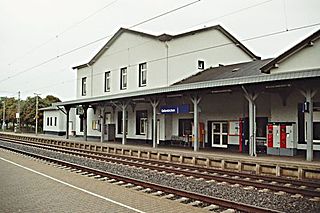
Geilenkirchen station is in Geilenkirchen in the German state of North Rhine-Westphalia on the Aachen–Mönchengladbach railway. It is the only railway station in the town of Geilenkirchen. It provided an interchange between the mainline railway and the Geilenkirchen District Railway until 1971 and was a stop for long-distance traffic until 2001. It is classified by Deutsche Bahn as a category 4 station.

Schwetzingen station is a through station in Schwetzingen, a town in the German state of Baden-Württemberg and lies not far from its centre. It is located at kilometre 13.6 of the Rhine Railway, which runs from Mannheim via Hockenheim and Graben-Neudorf to Karlsruhe. North of the station, the line to Mannheim-Friedrichsfeld branches to connect with the Main-Neckar Railway; the branch is almost exclusively used by freight. Until 1967, the Heidelberg–Speyer railway gave Schwetzingen direct connections to Heidelberg and Speyer. The only operating section of this line today is the section from Schwetzingen to the industrial area of Hockenheim-Talhaus, which is used for freight traffic.

Hochspeyer station – originally officially Neuhochspeyer or Neu-Hochspeyer – is the station of the town of Hochspeyer in the German state of Rhineland-Palatinate. Deutsche Bahn classifies it as belonging to category 4 and it has four platform tracks. The station is located in the network of the Verkehrsverbund Rhein-Neckar and belongs to fare zone 100. Its address is Bahnhofstraße 1.

Rödermark-Ober Roden station is the station of the Rödermark suburb of Ober-Roden in the German state of Hesse. It is the southern terminus of line S1 of the Rhine-Main S-Bahn and a stop for Regionalbahn services on the Dreieich Railway. It is classified in station category 4 and is a hub for public transport. The station building is a listed building.


